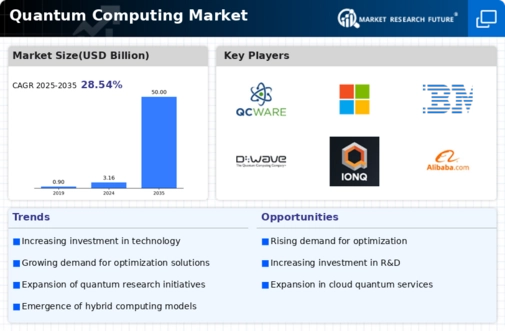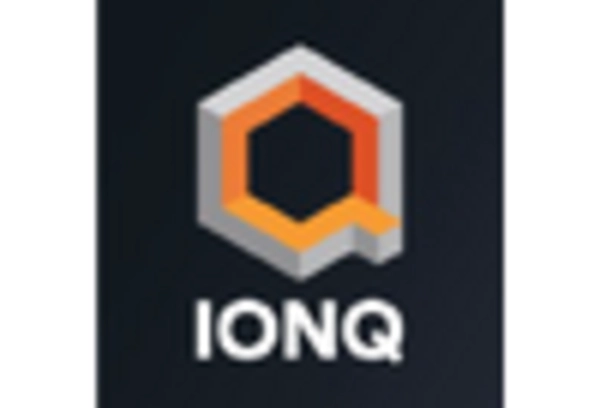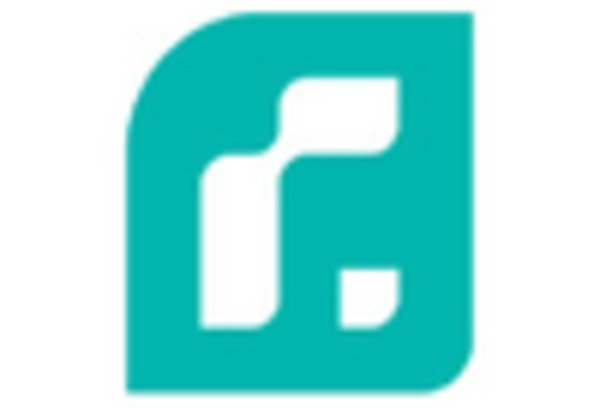Cryptography
Drug Discovery
Optimization Problems
Financial Modeling
Machine Learning
Hardware
Software
Services
Academic
Government
Enterprise
Superconducting Qubits
Trapped Ions
Topological Qubits
Photonic Quantum Computing
North America
Europe
South America
Asia Pacific
Middle East and Africa
North America Outlook (USD Billion, 2019-2035)
North America Quantum Computing Market by Application Type
Cryptography
Drug Discovery
Optimization Problems
Financial Modeling
Machine Learning
North America Quantum Computing Market by Component Type
Hardware
Software
Services
North America Quantum Computing Market by End Use Type
Academic
Government
Enterprise
North America Quantum Computing Market by Technology Type
Superconducting Qubits
Trapped Ions
Topological Qubits
Photonic Quantum Computing
North America Quantum Computing Market by Regional Type
US
Canada
US Outlook (USD Billion, 2019-2035)
US Quantum Computing Market by Application Type
Cryptography
Drug Discovery
Optimization Problems
Financial Modeling
Machine Learning
US Quantum Computing Market by Component Type
Hardware
Software
Services
US Quantum Computing Market by End Use Type
Academic
Government
Enterprise
US Quantum Computing Market by Technology Type
Superconducting Qubits
Trapped Ions
Topological Qubits
Photonic Quantum Computing
CANADA Outlook (USD Billion, 2019-2035)
CANADA Quantum Computing Market by Application Type
Cryptography
Drug Discovery
Optimization Problems
Financial Modeling
Machine Learning
CANADA Quantum Computing Market by Component Type
Hardware
Software
Services
CANADA Quantum Computing Market by End Use Type
Academic
Government
Enterprise
CANADA Quantum Computing Market by Technology Type
Superconducting Qubits
Trapped Ions
Topological Qubits
Photonic Quantum Computing
Europe Outlook (USD Billion, 2019-2035)
Europe Quantum Computing Market by Application Type
Cryptography
Drug Discovery
Optimization Problems
Financial Modeling
Machine Learning
Europe Quantum Computing Market by Component Type
Hardware
Software
Services
Europe Quantum Computing Market by End Use Type
Academic
Government
Enterprise
Europe Quantum Computing Market by Technology Type
Superconducting Qubits
Trapped Ions
Topological Qubits
Photonic Quantum Computing
Europe Quantum Computing Market by Regional Type
Germany
UK
France
Russia
Italy
Spain
Rest of Europe
GERMANY Outlook (USD Billion, 2019-2035)
GERMANY Quantum Computing Market by Application Type
Cryptography
Drug Discovery
Optimization Problems
Financial Modeling
Machine Learning
GERMANY Quantum Computing Market by Component Type
Hardware
Software
Services
GERMANY Quantum Computing Market by End Use Type
Academic
Government
Enterprise
GERMANY Quantum Computing Market by Technology Type
Superconducting Qubits
Trapped Ions
Topological Qubits
Photonic Quantum Computing
UK Outlook (USD Billion, 2019-2035)
UK Quantum Computing Market by Application Type
Cryptography
Drug Discovery
Optimization Problems
Financial Modeling
Machine Learning
UK Quantum Computing Market by Component Type
Hardware
Software
Services
UK Quantum Computing Market by End Use Type
Academic
Government
Enterprise
UK Quantum Computing Market by Technology Type
Superconducting Qubits
Trapped Ions
Topological Qubits
Photonic Quantum Computing
FRANCE Outlook (USD Billion, 2019-2035)
FRANCE Quantum Computing Market by Application Type
Cryptography
Drug Discovery
Optimization Problems
Financial Modeling
Machine Learning
FRANCE Quantum Computing Market by Component Type
Hardware
Software
Services
FRANCE Quantum Computing Market by End Use Type
Academic
Government
Enterprise
FRANCE Quantum Computing Market by Technology Type
Superconducting Qubits
Trapped Ions
Topological Qubits
Photonic Quantum Computing
RUSSIA Outlook (USD Billion, 2019-2035)
RUSSIA Quantum Computing Market by Application Type
Cryptography
Drug Discovery
Optimization Problems
Financial Modeling
Machine Learning
RUSSIA Quantum Computing Market by Component Type
Hardware
Software
Services
RUSSIA Quantum Computing Market by End Use Type
Academic
Government
Enterprise
RUSSIA Quantum Computing Market by Technology Type
Superconducting Qubits
Trapped Ions
Topological Qubits
Photonic Quantum Computing
ITALY Outlook (USD Billion, 2019-2035)
ITALY Quantum Computing Market by Application Type
Cryptography
Drug Discovery
Optimization Problems
Financial Modeling
Machine Learning
ITALY Quantum Computing Market by Component Type
Hardware
Software
Services
ITALY Quantum Computing Market by End Use Type
Academic
Government
Enterprise
ITALY Quantum Computing Market by Technology Type
Superconducting Qubits
Trapped Ions
Topological Qubits
Photonic Quantum Computing
SPAIN Outlook (USD Billion, 2019-2035)
SPAIN Quantum Computing Market by Application Type
Cryptography
Drug Discovery
Optimization Problems
Financial Modeling
Machine Learning
SPAIN Quantum Computing Market by Component Type
Hardware
Software
Services
SPAIN Quantum Computing Market by End Use Type
Academic
Government
Enterprise
SPAIN Quantum Computing Market by Technology Type
Superconducting Qubits
Trapped Ions
Topological Qubits
Photonic Quantum Computing
REST OF EUROPE Outlook (USD Billion, 2019-2035)
REST OF EUROPE Quantum Computing Market by Application Type
Cryptography
Drug Discovery
Optimization Problems
Financial Modeling
Machine Learning
REST OF EUROPE Quantum Computing Market by Component Type
Hardware
Software
Services
REST OF EUROPE Quantum Computing Market by End Use Type
Academic
Government
Enterprise
REST OF EUROPE Quantum Computing Market by Technology Type
Superconducting Qubits
Trapped Ions
Topological Qubits
Photonic Quantum Computing
APAC Outlook (USD Billion, 2019-2035)
APAC Quantum Computing Market by Application Type
Cryptography
Drug Discovery
Optimization Problems
Financial Modeling
Machine Learning
APAC Quantum Computing Market by Component Type
Hardware
Software
Services
APAC Quantum Computing Market by End Use Type
Academic
Government
Enterprise
APAC Quantum Computing Market by Technology Type
Superconducting Qubits
Trapped Ions
Topological Qubits
Photonic Quantum Computing
APAC Quantum Computing Market by Regional Type
China
India
Japan
South Korea
Malaysia
Thailand
Indonesia
Rest of APAC
CHINA Outlook (USD Billion, 2019-2035)
CHINA Quantum Computing Market by Application Type
Cryptography
Drug Discovery
Optimization Problems
Financial Modeling
Machine Learning
CHINA Quantum Computing Market by Component Type
Hardware
Software
Services
CHINA Quantum Computing Market by End Use Type
Academic
Government
Enterprise
CHINA Quantum Computing Market by Technology Type
Superconducting Qubits
Trapped Ions
Topological Qubits
Photonic Quantum Computing
INDIA Outlook (USD Billion, 2019-2035)
INDIA Quantum Computing Market by Application Type
Cryptography
Drug Discovery
Optimization Problems
Financial Modeling
Machine Learning
INDIA Quantum Computing Market by Component Type
Hardware
Software
Services
INDIA Quantum Computing Market by End Use Type
Academic
Government
Enterprise
INDIA Quantum Computing Market by Technology Type
Superconducting Qubits
Trapped Ions
Topological Qubits
Photonic Quantum Computing
JAPAN Outlook (USD Billion, 2019-2035)
JAPAN Quantum Computing Market by Application Type
Cryptography
Drug Discovery
Optimization Problems
Financial Modeling
Machine Learning
JAPAN Quantum Computing Market by Component Type
Hardware
Software
Services
JAPAN Quantum Computing Market by End Use Type
Academic
Government
Enterprise
JAPAN Quantum Computing Market by Technology Type
Superconducting Qubits
Trapped Ions
Topological Qubits
Photonic Quantum Computing
SOUTH KOREA Outlook (USD Billion, 2019-2035)
SOUTH KOREA Quantum Computing Market by Application Type
Cryptography
Drug Discovery
Optimization Problems
Financial Modeling
Machine Learning
SOUTH KOREA Quantum Computing Market by Component Type
Hardware
Software
Services
SOUTH KOREA Quantum Computing Market by End Use Type
Academic
Government
Enterprise
SOUTH KOREA Quantum Computing Market by Technology Type
Superconducting Qubits
Trapped Ions
Topological Qubits
Photonic Quantum Computing
MALAYSIA Outlook (USD Billion, 2019-2035)
MALAYSIA Quantum Computing Market by Application Type
Cryptography
Drug Discovery
Optimization Problems
Financial Modeling
Machine Learning
MALAYSIA Quantum Computing Market by Component Type
Hardware
Software
Services
MALAYSIA Quantum Computing Market by End Use Type
Academic
Government
Enterprise
MALAYSIA Quantum Computing Market by Technology Type
Superconducting Qubits
Trapped Ions
Topological Qubits
Photonic Quantum Computing
THAILAND Outlook (USD Billion, 2019-2035)
THAILAND Quantum Computing Market by Application Type
Cryptography
Drug Discovery
Optimization Problems
Financial Modeling
Machine Learning
THAILAND Quantum Computing Market by Component Type
Hardware
Software
Services
THAILAND Quantum Computing Market by End Use Type
Academic
Government
Enterprise
THAILAND Quantum Computing Market by Technology Type
Superconducting Qubits
Trapped Ions
Topological Qubits
Photonic Quantum Computing
INDONESIA Outlook (USD Billion, 2019-2035)
INDONESIA Quantum Computing Market by Application Type
Cryptography
Drug Discovery
Optimization Problems
Financial Modeling
Machine Learning
INDONESIA Quantum Computing Market by Component Type
Hardware
Software
Services
INDONESIA Quantum Computing Market by End Use Type
Academic
Government
Enterprise
INDONESIA Quantum Computing Market by Technology Type
Superconducting Qubits
Trapped Ions
Topological Qubits
Photonic Quantum Computing
REST OF APAC Outlook (USD Billion, 2019-2035)
REST OF APAC Quantum Computing Market by Application Type
Cryptography
Drug Discovery
Optimization Problems
Financial Modeling
Machine Learning
REST OF APAC Quantum Computing Market by Component Type
Hardware
Software
Services
REST OF APAC Quantum Computing Market by End Use Type
Academic
Government
Enterprise
REST OF APAC Quantum Computing Market by Technology Type
Superconducting Qubits
Trapped Ions
Topological Qubits
Photonic Quantum Computing
South America Outlook (USD Billion, 2019-2035)
South America Quantum Computing Market by Application Type
Cryptography
Drug Discovery
Optimization Problems
Financial Modeling
Machine Learning
South America Quantum Computing Market by Component Type
Hardware
Software
Services
South America Quantum Computing Market by End Use Type
Academic
Government
Enterprise
South America Quantum Computing Market by Technology Type
Superconducting Qubits
Trapped Ions
Topological Qubits
Photonic Quantum Computing
South America Quantum Computing Market by Regional Type
Brazil
Mexico
Argentina
Rest of South America
BRAZIL Outlook (USD Billion, 2019-2035)
BRAZIL Quantum Computing Market by Application Type
Cryptography
Drug Discovery
Optimization Problems
Financial Modeling
Machine Learning
BRAZIL Quantum Computing Market by Component Type
Hardware
Software
Services
BRAZIL Quantum Computing Market by End Use Type
Academic
Government
Enterprise
BRAZIL Quantum Computing Market by Technology Type
Superconducting Qubits
Trapped Ions
Topological Qubits
Photonic Quantum Computing
MEXICO Outlook (USD Billion, 2019-2035)
MEXICO Quantum Computing Market by Application Type
Cryptography
Drug Discovery
Optimization Problems
Financial Modeling
Machine Learning
MEXICO Quantum Computing Market by Component Type
Hardware
Software
Services
MEXICO Quantum Computing Market by End Use Type
Academic
Government
Enterprise
MEXICO Quantum Computing Market by Technology Type
Superconducting Qubits
Trapped Ions
Topological Qubits
Photonic Quantum Computing
ARGENTINA Outlook (USD Billion, 2019-2035)
ARGENTINA Quantum Computing Market by Application Type
Cryptography
Drug Discovery
Optimization Problems
Financial Modeling
Machine Learning
ARGENTINA Quantum Computing Market by Component Type
Hardware
Software
Services
ARGENTINA Quantum Computing Market by End Use Type
Academic
Government
Enterprise
ARGENTINA Quantum Computing Market by Technology Type
Superconducting Qubits
Trapped Ions
Topological Qubits
Photonic Quantum Computing
REST OF SOUTH AMERICA Outlook (USD Billion, 2019-2035)
REST OF SOUTH AMERICA Quantum Computing Market by Application Type
Cryptography
Drug Discovery
Optimization Problems
Financial Modeling
Machine Learning
REST OF SOUTH AMERICA Quantum Computing Market by Component Type
Hardware
Software
Services
REST OF SOUTH AMERICA Quantum Computing Market by End Use Type
Academic
Government
Enterprise
REST OF SOUTH AMERICA Quantum Computing Market by Technology Type
Superconducting Qubits
Trapped Ions
Topological Qubits
Photonic Quantum Computing
MEA Outlook (USD Billion, 2019-2035)
MEA Quantum Computing Market by Application Type
Cryptography
Drug Discovery
Optimization Problems
Financial Modeling
Machine Learning
MEA Quantum Computing Market by Component Type
Hardware
Software
Services
MEA Quantum Computing Market by End Use Type
Academic
Government
Enterprise
MEA Quantum Computing Market by Technology Type
Superconducting Qubits
Trapped Ions
Topological Qubits
Photonic Quantum Computing
MEA Quantum Computing Market by Regional Type
GCC Countries
South Africa
Rest of MEA
GCC COUNTRIES Outlook (USD Billion, 2019-2035)
GCC COUNTRIES Quantum Computing Market by Application Type
Cryptography
Drug Discovery
Optimization Problems
Financial Modeling
Machine Learning
GCC COUNTRIES Quantum Computing Market by Component Type
Hardware
Software
Services
GCC COUNTRIES Quantum Computing Market by End Use Type
Academic
Government
Enterprise
GCC COUNTRIES Quantum Computing Market by Technology Type
Superconducting Qubits
Trapped Ions
Topological Qubits
Photonic Quantum Computing
SOUTH AFRICA Outlook (USD Billion, 2019-2035)
SOUTH AFRICA Quantum Computing Market by Application Type
Cryptography
Drug Discovery
Optimization Problems
Financial Modeling
Machine Learning
SOUTH AFRICA Quantum Computing Market by Component Type
Hardware
Software
Services
SOUTH AFRICA Quantum Computing Market by End Use Type
Academic
Government
Enterprise
SOUTH AFRICA Quantum Computing Market by Technology Type
Superconducting Qubits
Trapped Ions
Topological Qubits
Photonic Quantum Computing
REST OF MEA Outlook (USD Billion, 2019-2035)
REST OF MEA Quantum Computing Market by Application Type
Cryptography
Drug Discovery
Optimization Problems
Financial Modeling
Machine Learning
REST OF MEA Quantum Computing Market by Component Type
Hardware
Software
Services
REST OF MEA Quantum Computing Market by End Use Type
Academic
Government
Enterprise
REST OF MEA Quantum Computing Market by Technology Type
Superconducting Qubits
Trapped Ions
Topological Qubits
Photonic Quantum Computing

















Leave a Comment